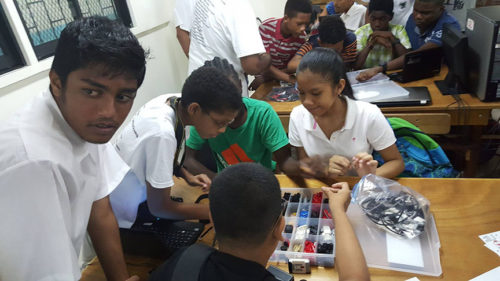By Karen Abrams and Leon Caleb
Watching the youngsters put the finishing touches to the arrangements for Guyana’s first National Robot Exhibition which takes place at the Cliff Anderson Sports Hall tomorrow, Saturday June 24, we are inclined to reflect on the impact that the STEMGuyana project has made on the lives of hundreds, perhaps thousands of Guyanese youngsters. We have come a long way from the summer of 2016 when scores of wide-eyed children from various parts of Guyana including Lusignan, Buxton, Georgetown, Kuru Kuru and local high schools including President’s College, the Bishops and St Rose’s flocked the various centres, many of them out of no more than a healthy measure of curiosity. Tomorrow, some of those children will put their robot-making skills on display.

We, too, are anxious. We are keenly looking forward to using the event to help measure the impact that the STEM programme has made here. We hope, indeed, we expect, that students and young people from primary to tertiary levels of education and even those not in school, are encouraged to attend. Families, naturally, are welcome too. We believe that attendees are in for a mind-blowing day of technology fun, learning and prizes.
STEM’s vision goes beyond that. We are already focused on the preparations of the STEMGuyana National Robotics team for the International Robotics Tournament in Washington DC, where they will join more than 160 countries in pursuit of a solution to water-contamination challenges utilizing robot technology.

With all of the excitement around robotics and technology globally, it is clear that a yawning digital divide still exists in Guyana. The divide is not simply about who has access to computers and the internet and who does not, it is also mental, an imagined rather than a real line that exists, tragically, in the minds of our ‘gatekeepers’ in Guyana.
That divide is reflected in a persistent perception by some that advances in technology involve possession of the latest electronic devices; or the lack of interest by many in collaborating today to prepare Guyanese youth to take economic control of their country tomorrow; or the persistent perception that STEM education involves Math, that Math is difficult and by extension that STEM is only for ‘certain people.’ While we believe that some influencers (leaders) understand the urgency of investing in STEM, some do not. That too is regrettable.
In most other countries, the digital divide is often a reflection of class or economics, not so in Guyana; here, the divide exists among leaders in the private sector, in politics, and among the citizenry. It has little to do with either class or economics.
By the same token, there are corporate leaders in Guyana who get the importance of STEM and others who don’t; there are politicians who get it and some who don’t. It is the same, regrettably, with educated people and with people in the media.
Since its inception in 2016 STEMGuyana has seen exponential growth. Last year we held four robotics workshops. Out of those workshops and in partnership with the Guyanese community, both here and abroad, more than ten STEM clubs have been created. Those club leaders have worked to pass on the knowledge to yet another group of youth and the growth is expected to continue. STEMGuyana, in association with local and external partners, will launch an ambitious national initiative designed to bring organized technology education to young people across Guyana.
In addition to engaging, inspiring and educating community youth, the proceeds from tomorrow’s exhibition will partially fund the STEMGuyana Robotics Team’s preparations for the Washington and the staffing and equipping of STEMGuyana’s Secretariat – along with technology trainers – the details of which will be announced shortly. Our goal is to take our mission all across Guyana. We also propose to enroll STEM club members in our Math, Programming and Robotics leagues. The leagues will be national and international and will challenge students to strengthen their critical thinking, problem solving and innovation skills while earning them fun prizes like tablets and laptops.
Guyana’s tech companies of tomorrow will not only create opportunities for Guyana and her people, but the revenues that these are likely to generate will dwarf those generated by the companies which, today, we regard as successful.
These companies have a clear vision into the future; they understand that they will need highly skilled employees and that the future success of their companies will require a more educated population. The new frontier will be developed by new leaders, people like Eldon Marks, Ronson Gray, Ryon Persaud and others. They will lead our country into future of innovation, problem solving and global commerce.
The challenge that STEMGuyana has accepted is to work with those leaders who understand the importance and urgency of STEM infrastructure investment, to bridge the digital divide at the citizen level.





